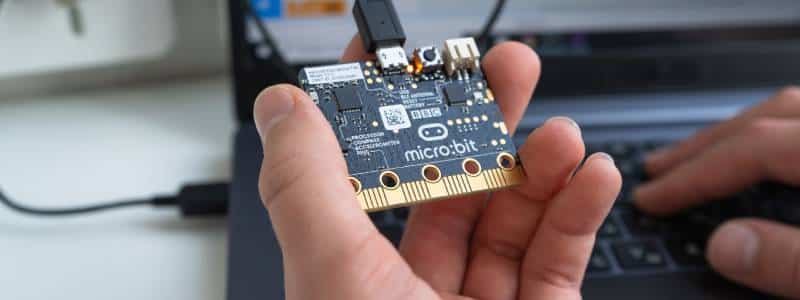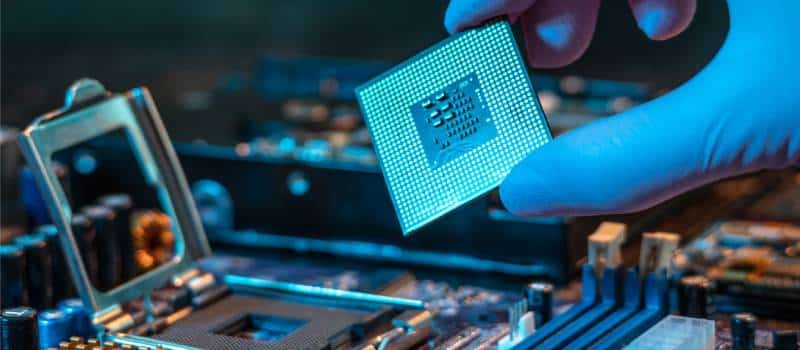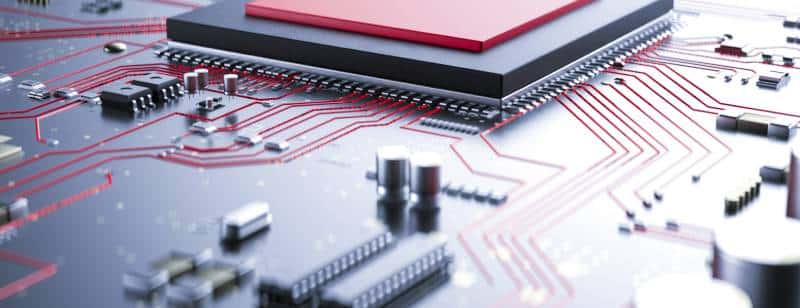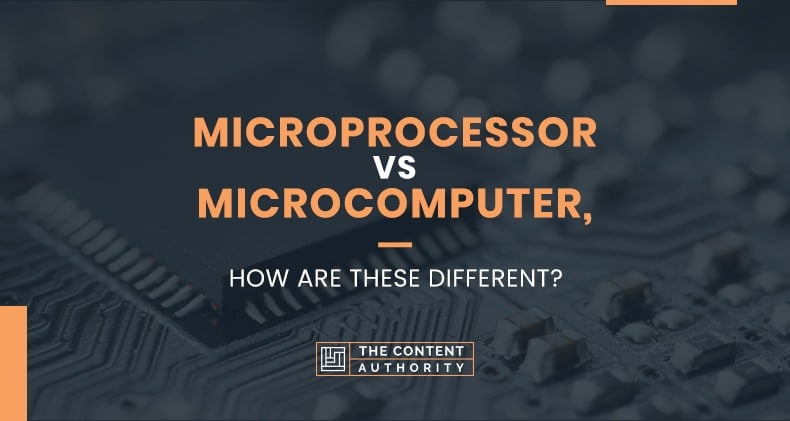Some of the particular specifications of the microprocessor may confuse you because it does many of the same things a microcomputer does. The microprocessor can do one task in a fraction of seconds, but the microcomputer can make multi-tasks in specific ways with the need of one or more microprocessors.
Microprocessor and Microcomputer are not the same. The main difference is that the microprocessor is a computer processor in an integrated circuit chip, and the microcomputer is a small, relatively inexpensive computer. The microcomputer holds a microprocessor inside and not the other way around.
Microprocessor
This is the central processing unit (CPU) of a computer system that conducts arithmetic and logic tasks such as adding, subtracting, moving numbers from one region to another, and comparing two numbers.
It is frequently referred to as a processor, a central processing unit, or a logic chip. When the computer is turned on, it is essentially the engine or the computer’s brain that gets things moving. It is a programmable, multifunction device that combines the operations of a CPU (central processing unit) on a single integrated circuit (IC) (integrated circuit).
Origin Of The Phrase
The term “microprocessor” was used by Viatron Computer Systems to describe the unique integrated circuit used in their System 21 small computer system, which was released in 1968.
History
A microprocessor is a computer processor that contains the operations of a central processing unit on a single integrated circuit (IC) or a few integrated circuits.
The microprocessor is a multifunctional, clock-driven, register-based digital integrated circuit that receives binary data as input, according to guidelines stored in its memory and processes it, and outputs the results.
Microprocessors feature both combinational logic and sequential digital logic. Microprocessors work with numbers and symbols represented by the binary number system.
Integrating an entire CPU onto a single or a few integrated circuits decreased the cost of processing power significantly. Integrated circuit processors are mass-produced using highly automated techniques, resulting in a low unit price.
Because there are fewer electrical connections that might fail with single-chip computers, dependability improves. According to Rock’s rule, as microprocessor designs improve, the cost of producing a chip (with smaller components placed on a semiconductor chip of the same size) typically remains constant.
Small computers were developed before microprocessors utilizing racks of circuit boards with many medium- and small-scale integrated circuits.
Microprocessors combined this into one or a couple of large-scale integrated circuits (ICs). Continuous advancements in microprocessor capacity have rendered earlier computers nearly obsolete (see history of computing hardware). One or more microprocessors utilized everything from the tiniest embedded systems and portable devices to the largest mainframes and supercomputers.
A microprocessor is a computer control unit capable of managing all Arithmetic Logical Unit (ALU) activities. Other actions that a microprocessor may do include computational processes such as addition/subtraction, internal processing, device terminal connectivity, and I/O management.
How People Use The Phrase
This word is not a phrase we use every day because the main uses have been replaced by more popular names now like laptops and desktops.
Examples:
- Technically, anything having a microprocessor qualifies as a robot.
- The PS3 also uses an IBM-designed CPU known as the Cell microprocessor.
- A microprocessor is a smart plastic card containing a microprocessor and memory.
- Each one has a microchip with a microprocessor and several kilobytes of memory.
- You can be responsible for designing low-power, portable, microprocessor-controlled data loggers from idea to manufacturing.
Microcomputer
It is an electronic device with a central processing unit that is a microprocessor. It was once a frequent word for personal computers, specifically any family of compact digital computers with a CPU housed on a single integrated semiconductor chip.
This is used for exchanging data of this sort with peripheral devices (e.g., keyboard, video display, and printer) and auxiliary storage units. The earliest microcomputers marketed in the mid-1970s contained a single chip on which all CPU, memory, and interface circuits were integrated.
As large-scale integration and then very-large-scale integration progressively increased the number of transistors placed on one semiconductor chip, microcomputers’ processing capacity using such single chips grew commensurately.
Origin Of The Phrase

In the early 2000s, everyday use of the word “microcomputer” declined significantly from its peak in the mid-1980s. The phrase is most commonly connected with the most popular all-in-one 8-bit home computers and small-business CP/M-based microcomputers.
Because a growing number of devices based on current microprocessors lack the most frequent feature of “microcomputers,” an 8-bit data bus, they are rarely referred to as such in daily conversation.
In everyday usage, “microcomputer” has mainly been substituted by the phrase “personal computer” or “PC,” which specifies a computer that has been created for one user at a time, a term first made up in 1959.
History
The phrase microcomputer dates back to the 70s. The advent of the Intel 4004 microprocessor in 1971; the Intel 8008 and Intel 8080 microprocessor in 1972 and 1974 paved the path to creating the microcomputer.
1The first microcomputer, known as the Micral, was released in 1973. It was the first non-kit computer to use an Intel 8008 microprocessor. Micro Computer Machines Inc. released the Intel 8008-based MCM/70 microcomputer in 1974.
Following the Micral and MCM/70, the microprocessor Altair 8800 was introduced, and it is often regarded as the first successful commercial microcomputer. Micro Instrumentation Telemetry Systems (MITS) created it, and it was based on the Intel 8080 microprocessor.
The processing capacity of microcomputers increased as microprocessor chip design matured.
Microcomputers were widely utilized in personal computing, workstations, and academia by the 1980s and were used for more than just games and computer-based pleasure.
Microcomputers were first developed as pocket-sized personal digital assistants (PDAs) in the 1990s, and they eventually evolved into cell phones and portable music players.
How People Use The Phrase

This phrase is not a phrase we use every day because the main uses have been replaced by more popular names now like laptops and desktops.
Examples:
- She took out her microcomputer and placed it in her handbag.
- James Bond has a microcomputer integrated into his car.
- Microcomputers are quite popular nowadays.
- They decided to buy a microcomputer instead of the more classic option.
- The microcomputer is not a toy but a tool.
Applications
Personal computers are frequently utilized for education and entertainment purposes. Microcomputers and laptops, and desktop computers can include video game consoles, computerized gadgets, and cellphones.
Microcomputers have been utilized in the workplace for various applications such as data and word processing, electronic spreadsheets, professional presentation and graphics programs, communications, and database management systems.
Microcomputers are used in business for duties such as inventory and communication; in medical settings, they are used to record and recall patient data, manage healthcare plans, complete timetables, and analyze data.
Microcomputers can be used in financial institutions to record transactions, track bills and payrolls, and audit and military applications for training gadgets.
Microcomputers vs. microprocessors

Starting to explain what a microprocessor is, I can say it is a computer processor housed on a microchip and contains all or most CPU operations. Microprocessors lack RAM, ROM, and other peripherals. As a result, microprocessors are incapable of doing stand-alone tasks.
Instead, systems containing microprocessors, such as microcomputers, may be configured to perform operations on data by programming specific instructions for their microprocessors into their memory.
A microcomputer is theoretically a mix of a microprocessor and its peripheral I/O devices, circuitry, and memory – but not all on the same chip.
Conclusion
Microcomputers are designed to serve only one user simultaneously, although they can often receive updates with software or hardware to do more than one user concurrently.
The availability of cheap microprocessors enabled computer engineers to create microcomputers. These computer systems are compact but powerful enough to handle various corporate, industrial, and scientific applications.
Shawn Manaher is the founder and CEO of The Content Authority. He’s one part content manager, one part writing ninja organizer, and two parts leader of top content creators. You don’t even want to know what he calls pancakes.

